Running Dry: One Man’s Journey to Raise Awareness About the Shrinking Colorado River
In 2008 journalist and photographer Jon Waterman spent five months traveling the Colorado River to understand the extent of its shrinking. Waterman published his journey in Running Dry: A Journey from Source to Sea Down the Colorado River, which was released in May as part of his awareness campaign, the Colorado River Project. Here’s a look at the first chapter, and the start of Waterman’s exploration.
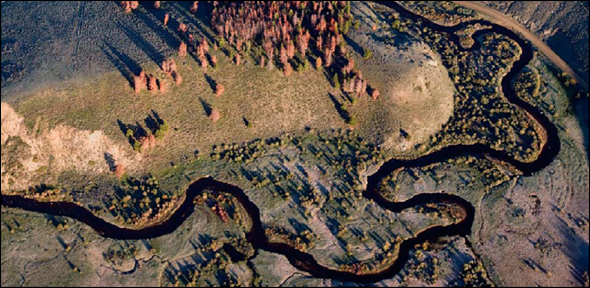
By Jon Waterman
Special to Circle of Blue
On the last day of May, after the heaviest winter in 20 years, I shoulder a pack with a large satchel of my mother’s ashes, a pair of snowshoes, and a deflated Alpacka raft with collapsible paddles. The Colorado River begins seven and a half miles and 1,500 feet above.
Early this morning, we drove for an hour from the arid eastern plains of Colorado toward Longs Peak, 14,259 feet. Plains farmers used to gauge their summer water supply by gazing up at the mountain’s wineglass-shaped snowfield, visible from a hundred miles away. If the glass wasn’t filled, it foretold a bad crop year. This year, the snow has spilled out over the entire mountainside.
Before the understaffed Rocky Mountain National Park rangers could begin charging at the park entrance, we drove above the tree line and past the oft-studied peak on Trail Ridge Road, confined by 10-foot snowbanks. A vertical mile below, we reached the Colorado River trailhead.
In contrast to the windblown eastern side, we’re deep in snow. The Rockies rake incoming storms, pull the moisture onto the western slope, and funnel the empty winds out over the eastern plains.
The high altitude, opaque stream water beside us turns chocolate as the temperature rises, and water begins to pour out of untold ravines, unlocking mud banks, thawing snowfields, and bursting toward sea level more than a thousand miles away. The pace of my hiking companion, Brad Udall, quickens, even though his pack—freighted with heavy-metal back country skis and bindings—is a great deal heavier than mine. Brad is vexed that the Colorado River no longer reaches the sea. The water bee-lining past our feet and wetting our socks should “slake the thirst of you, me and thirty million others who live in this gargantuan river basin, or evaporate from immense desert reservoirs downstream.”
He talks with the slow cadence of a native Westerner. His mind holds a hard-earned map of the rivers and ranges of these parts. Nor does it hurt that five generations and two dozen of his kin have run municipal, state, or federal political offices. Since the mid-19th century, the Udall family dynasty, like all Western politicians, has trafficked in water. Or the lack thereof. So it’s not a stretch to say that the river runs through Brad Udall’s veins.
Brad, pushing 50 years old, churns out water facts as we follow the stream growing beside us. A former boatman in the Grand Canyon, he’s fit from backcountry skiing those weekends he doesn’t hit the lecture and sustainable water use circuit as the director of Western Water Assessment, based out of the National Oceanic and Atmospheric Administration (NOAA) offices in Boulder.
We ford a rivulet, climb another steep hill, and amid a thick pine forest, tiptoe across the crust of melting snowbanks, mined with three-foot sunken leg holes of hikers who passed earlier in the week without snowshoes. In a sun-drenched meadow, a kingfisher zippers through the air, rattling loudly against our intrusion. We stop and strip off our outer jackets as the now meandering stream lowers its burbling a decibel.
In northern Arizona during the late 19th century, Brad’s great-great grandfather,John D. Lee, started Lees Ferry, pulling flat-bottomed boats across the river with a cable. A dozen miles upstream of this landmark, in 1961, Brad’s uncle, Secretary of the Interior Stewart Udall—aka “Colorado River Master”—oversaw the building of the West’s most disputed mass of concrete, the Glen Canyon Dam. His father, “Mo” Udall, was the one-time presidential candidate and Arizona representative who defended that state’s Colorado River water rights, while Brad’s brother Mark and their cousin Tom represent Colorado and New Mexico as congressmen now running shoo-in campaigns as senators. No one would dispute that Brad has found his calling as a spokesman for the river.
He says that today’s growing problem with the shrinking river began with a climate miscalculation. Beginning in 1896, the U.S. government measured the Colorado River volume through acre-feet, the amount of water that would cover an acre of land one-foot deep. !ey guesstimated the river’s average flow at 17.5 million acre-feet (maf), almost six trillion gallons per year. That’s enough water to support 35 million modern households.
Yet scientists have recently figured out that the Colorado River’s volume was calibrated following one of the wettest periods in its history. By measuring the distance between tree rings, hydrologists found growth rates that matched river volumes. Hydrologists determined that the region has experienced more severe droughts over the last several hundred years, Brad tells me, than yet experienced in the 21st century. This means that droughts are going to get worse before they get better. Over the centuries, the river has averaged little more than 15 maf per year—2.5 maf less than the seven member states and Mexico have divvied up. I’ll learn more about the significance of these numbers as I head downstream.
I have come to the Colorado River to paddle all 1,450 miles and learn about what’s at stake. Not only what’s already been damaged, but also what we might lose in the future without proper solutions or conservation. Water, first of all. Then more cogently, the river itself, a living resource that includes wildlife and plant species, reservoirs, Native American culture, recreation, river-based economies, and the ever-shrinking wetlands of the delta. My family lives in Colorado and I want them to revel in the living resource of water—skiing the Rockies’ snow, paddling its melt waters, and watering our garden—as I have for the last 20 years. But a half century from now, according to the forecasts of many climatologists, my sons are likely to see the ski resorts of Colorado go dry before their knees give out.
Climate models for the second half of this century show that up to 70 percent of the snowpack, which supplies the river 90 percent of its water, will disappear. Despite a whopping snowfall and long winter in the Upper Basin, the two biggest reservoirs created by Hoover and Glen Canyon Dams, “Lakes” Mead and Powell, are presently at half of their collective 50-maf capacities and are unlikely to recharge from the winter’s big snowfall after meeting their downstream orders to create electricity and fill irrigation ditches.
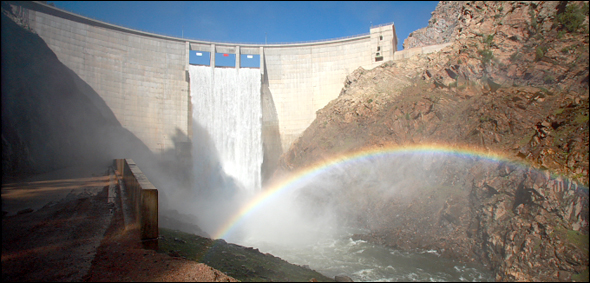
If this nine-year drought continues on beyond a decade, as predicted, life throughout the river basin will be irrevocably changed. First, the sprawling economy created by recreational river and reservoir use throughout the river basin will go bust—crippling scores of towns and small cities along the river. Swimming pools will be drained and lawns browned in Salt Lake City, Utah, Cheyenne, Wyoming, and Albuquerque, New Mexico. Without Hoover Dam generating relatively clean and rapidly created hydroelectric power, Los Angeles will have blackouts. Without Glen Canyon Dam powering air conditioners, people will abandon sweltering Phoenix, necessitating the construction of more noxious, water consumptive coal plants on the far reaches of the energy grid. Several million acres of farms in the Southwest—including Imperial Valley, the fifth richest agricultural region in the country—will go fallow. Without radical change, citizens in Denver, Colorado, Las Vegas, Nevada, and San Diego, California, will have trouble flushing their toilets. Thirty million people will begin losing their drinking water. Finally, thanks to the antiquated Colorado River Compact, lawsuits will lock up what little water remains in what is already known as the most diverted river in the world.
Today, the driest states in the country are now among the most waterdependent and fastest-growing states. Eight decades ago, the Colorado River Compact split up the river between Mexico, Arizona, California, Nevada, New Mexico, Utah, Wyoming and Colorado. In that time, the basin states’ population of five million increased tenfold. Compounding this dilemma are droughts, an over-allocated river, and increasing global temperatures.
Brad’s brow furrows as he discusses the shrinking river. He fires off facts and figures with the speed of a Wall Street ticker tape showing the futures market. Keeping to the Western Water Assessment’s mission of science, he avoids the rhetoric of environmentalists, whom he refers to as “enviros.”
Like the other jack Mormons in his family, he is lean and tall, with thick eyebrows, and a long jawline that contributes to a craggy handsomeness. As the snow deepens, Brad and I are happy to lighten our packs by caching our five-pound Alpacka rafts and paddles in a greening aspen forest. We strap on our skis and snowshoes. It would be vainglorious to try to boat down the snowed-over, steepening stream.
Brad points to La Poudre Pass, our destination, where the Continental Divide runs north to south, dividing Rocky Mountain National Park hydrologically. Waters on the west side form the Colorado River headwaters, running to the Pacific, while the east side drains to the Mississippi and the Atlantic. At least this is how nature intended it.
Above our heads, the Never Summer Mountains hold the snow that used to form the first drops of the river. Before this snowmelt can drain into the shrunken stream at our feet, a ditch intercepts the water, sluicing it over La Poudre Pass into Long Draw Reservoir, and off to the crops on the eastern plains. !e ditch appears like a surgical scar shaved across the heavily wooded face of the Never Summers. Farther west, a bulldozer rumbles along an adjacent dirt road, clearing out ice jams to keep the water from flooding over the ditch and into the valley below. Brad’s congressman brother, Mark Udall, has championed a bill that will make this corner of Rocky Mountain National Park official wilderness. Five years ago, the ditch flooded the park’s valley floor and caused $9 million in damage to dozens of historic cabins amid flower-strewn meadows. Now with protected wilderness status, the park can bill the ditch owners for the damage instead of suing.
Like other states in the river basin, Colorado developed around the ability to manipulate water. Financiers knew that “water runs uphill to money,” and so does this ditch, pumped at a one percent grade over the Continental Divide.
As evidence of this water-as-gold maxim, in Colorado, we cannot legally catch rain in our gutters to water our gardens, because Brad and I live under the doctrine of prior appropriation—or first in time, first in right—meaning that someone below us already owns the water. These rights can be bought and sold separately from whatever rights we’d like to think we own on our roofs, high above and far away from any farmer. In times of drought, the owner of the oldest water right, regardless of distance from the river or its headwaters, reserves the right to use the water. !is explains why ranchers and farmers 80 miles to the west in Grand Junction, Colorado, or 80 miles to the east in Fort Morgan, Colorado, own the water that falls on our Carbondale or Boulder roofs.
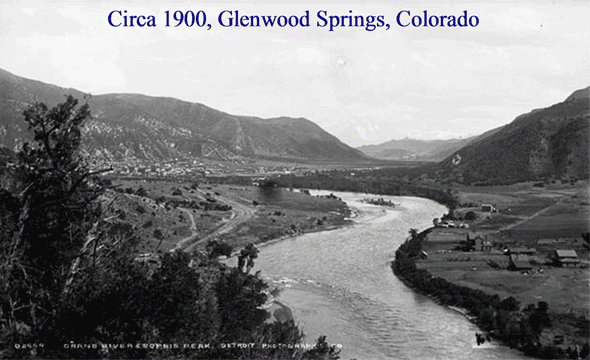
Yesterday, I’d met with Brad at the NOAA offices in Boulder, and his boss, the Director of the Earth System Research Lab. Sandy McDonald oversees 600 scientists studying weather and climate. In a small, empty auditorium, Sandy showed off a five-foot “Science On a Sphere” globe, lit from within by climate data. He pointed out Africa’s Sahara Desert to remind me of the difference between a desert and a drought. We took several steps around the planet to North America and watched as a computer operator in an adjacent room programmed climate data onto the globe for 1970 and 2007, to show the effects of the drought. Over 37 years, the color change from blue to yellow over the Colorado River Basin showed a temperature increase of 3 degrees Fahrenheit. Along with the globe’s color-temperature changes, a numerical overlay displayed particulate matter in the atmosphere in 1970 and 2007, increasing from 327 parts per million (ppm) to 387 ppm, showing how greenhouse gases have caused the drought and changing climate by warming the atmosphere. In past millennia, similarly high levels have caused melting sea ice, a 10-foot rise in ocean levels, and a drier climate.
Amid these shocking statistics, I asked what NOAA, a governmentfunded agency, has forecast for future climate change in the Colorado River Basin. Sandy deferred to Brad, who replied that, by 2050, the snowpack will thin by a factor of 5 percent to 50 percent. In terms of the future of the river, even a 10 percent reduction in the river’s snowpack water supply could trigger catastrophic reductions throughout the basin amid increasing population pressures for water.
“When you factor in the earlier runoffs caused by dust now overlaying the snow,” Brad added, “raised by development across the West, and causing water to enter the river a month earlier than historic norms, there’s another huge evaporative loss of up to five million acre feet when the water hits the reservoirs.” He’s referring to the heat gain caused by dark dust on the snow surface, absorbing the sun’s energy and melting the snow in spring instead of reflecting the sun and preserving the snowpack until summer.
On this 68-degree day on the river’s headwaters, because of the downed trees we’re constantly forced to climb around, and my own breathlessness from chasing Udall uphill, I don’t ask Brad to defend the science that explains changing climate. Those of us who live for their time spent out of doors in the West have already experienced obvious changes over the last two decades. Amid the rising temperatures, we’ve seen lengthening summers, haze caused by large Western forest fires, and watering restrictions brought on by drought. This is the first May in 20 years that we’ve needed snowshoes or skis at this elevation.
We’re climbing over, walking around, and ducking under a direct effect of the drought caused by climate change. Here in the Colorado River drainages of Grand County and neighboring Summit County, beetles have infested a
thousand square miles of lodgepole pine forests. As we climb to a deforested knob, downstream we can spy a sea of formerly green pine boughs turned dead as a red tide. Although I can’t actually see the rice grain–sized Dendroctonus ponderosae beetles, we’re surrounded by hundred-foot trees exhibiting sappy extrusions from beetles eating the inner bark and killing the tree. The lengthening summers have increased the beetles’ reproductive cycle to twice a year. The lack of subzero, beetle-killing winters has created a tree-eating orgy.
Brad explains that pine beetles have existed in the West since the Pleistocene, but this is the worst outbreak in state history. Foresters are predicting that beetles will destroy all of Colorado’s lodgepole forest—an area the size of Rhode Island—in the next few years. Recently, the beetles have defied the former high-altitude cold barrier by jumping the Continental Divide and infesting eastern slope forests in the park and on toward the plains. At some point, fires will follow. In the past, without 50 million people living in the West, wildfires burned without suppression, regenerating the landscape with new growth.
With a sea of reddened trees standing like matchsticks waiting for a flame, the risks are obvious. Throughout public places along the Colorado River headwaters, “Survive Alive!” fliers are pinned up in eye-catching yellow and orange, instructing citizens to attend meetings and help create evacuation plans for when the “CATASTROPHIC WILDFIRE” arrives.
Weary from postholing the trail’s softening snow with downed trees as high hurdles blocking our way, Brad takes off his skis, jabs his thumb north, and begins striding steeply uphill. I eye the gently contouring trail with a last bit of longing. As Brad bushwhacks at a right angle up away from the trail, breaking the snow up to his hips every few steps, I manage to keep him in sight. After a half an hour of sweating and cursing labor, we reach a narrow dirt road alongside the several-foot-wide Grand Ditch. Out of the shaded forest, we apply more sun lotion as we walk. Ice bergie bits jam up, roll, and then sail no faster than our three-mile-an-hour pace.
In 1894, the Water Supply and Storage Company hired Chinese, Swedish and Mexican laborers to dig the ditch, a thousand feet above what used to be called the Grand River. Until the early 20th century, the Colorado River didn’t officially start until 451 miles downstream from here in Utah, at the confluence of the Green and Grand Rivers amid red rock canyons. The longest of the Colorado tributaries, the Green River originates from more than 700 miles north, in the Wind River Mountains of Wyoming. And because the Utah legislature knew that the Green River ran several hundred miles longer than the other Colorado River tributary then called the Grand River, they debated renaming the Green the Colorado River. At the same time, Colorado’s representative Edward Taylor sought to bolster tourism in his hometown of Glenwood Springs, Colorado. In 1921, he proposed to Congress that the Grand River be renamed the Colorado. President Harding signed the bill, peeving both Utah and Wyoming lawmakers. Thanks to the allure of the well-known name, Glenwood Springs reaped a flood of tourists on the now-elongated Colorado River.
The state of Colorado is rife with dams, ditches, and tunnels that breach the Rockies, having diverted the river’s headwaters long before concrete started pouring downstream. In 1936, backhoes lengthened the efforts of earlier shovelers on the 16-mile-long Grand Ditch. The Water Supply and Storage Company’s “engineering marvel” intercepted over six million gallons of Never Summer Mountain streams and sent them plunging down the Cache La Poudre River to the distant eastern plains. The advantage of midsummer snowmelt is that farmers can open their ditches with all the convenience of filling a pitcher from the refrigerator. Also, the system has only one small dammed reservoir—Long Draw—minimizing loss from evaporation.
After the Grand Ditch was finished, the Colorado River below turned into a lazy creek, seen from a high switchback on the Trail Ridge Road as a looping brown intestine of water. During the last nine years of drought, the river has trickled out of the park and down to Grand Lake. Although flood cycles seldom recharge flora on the banks, valuable homes and ranches downstream remain intact. And so begins the long-justified saga of reclamation— protecting property from floods, growing crops, creating hydroelectricity, and providing recreation—from every ditch, diversion, and dam built between here and the sea.
As Brad and I round the final corner of the ditch road, breaking out toward the open meadows of 10,175-foot La Poudre Pass, we spy the Christmas-tree-shaped Long Draw Reservoir. Its descending waterlines have caused 50-foot-high bathtub rings, stained by minerals pulled out of the Never Summers. These bathtub rings are now emblematic of the drought lowering a hundred reservoirs throughout the Colorado River Basin, like a warning postscript to the reclamation saga.
“Nice view, huh?” Brad asks rhetorically. “It’s for watering subsidized alfalfa to feed subsidized cows out on the plains.” He continues with the suggestion that, if we raised the price of utilities instead of subsidizing the cost of water and electricity, we’d quickly find solutions for conserving water and electricity. “Just like what we’re seeing with rising gas prices.”
During the hike, I’ve learned that part of Brad’s work, as both a Udall and the director of Western Water Assessment, is spreading the news that climate change is here to stay. “In terms of the Colorado River, the higher temperatures will increase the atmosphere’s moisture-holding capacity and evaporation will increase, further draining the reservoir capacities,” he ticks the points off on his fingers. “Then there’s drought. The evaporation will increase water demand and summertime drying. And then there’s the earlier spring runoff. . . .”
We cut across a meadow above a small lake shown on the map, but apparently long since dried up. It’s late afternoon, and although Brad isn’t showing any pain, I’m overheated and blistered from the hike. I pull off my pack. A Steller’s jay wings a croaking, erratic path above us on the snow-covered meadow, but our day otherwise seems a subdued and unlikely beginning for such an iconic river.
Above, tall green trees—possibly still free of pine beetles—climb several thousand feet up the remnant volcanoes. In the distance, we can still hear a clanking, sputtering backhoe, scooping ice jams out of the Grand Ditch. I turn to the west, lift the bag high, and spill the ashes of my mother into the breeze above the remains of the Colorado River headwaters. It’s a long story, but I’m hoping she’ll join me during the long descent to the Pacific.
Jon Waterman is a journalist and photographer who launched the Colorado River Project after spending five months traveling the river in 2008. Read more about the Colorado River on Circle of Blue.
Circle of Blue provides relevant, reliable, and actionable on-the-ground information about the world’s resource crises.

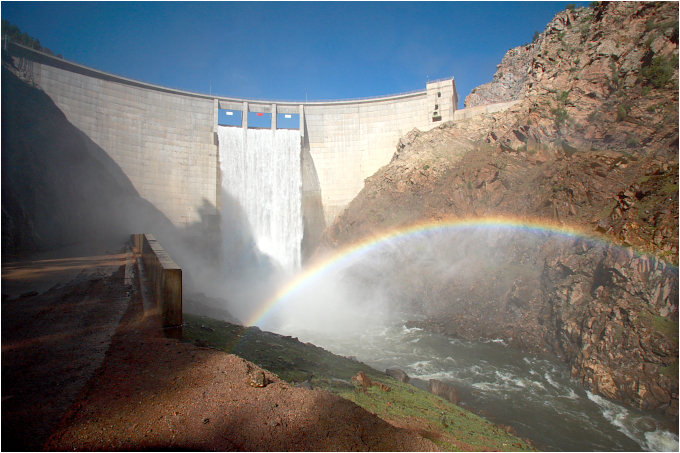
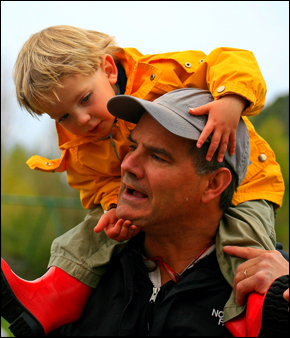
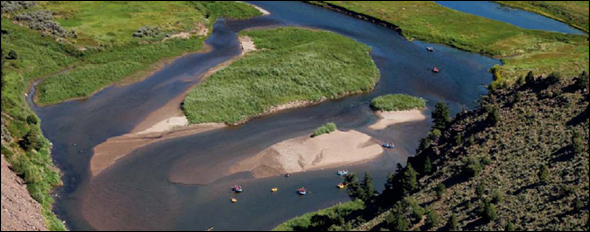

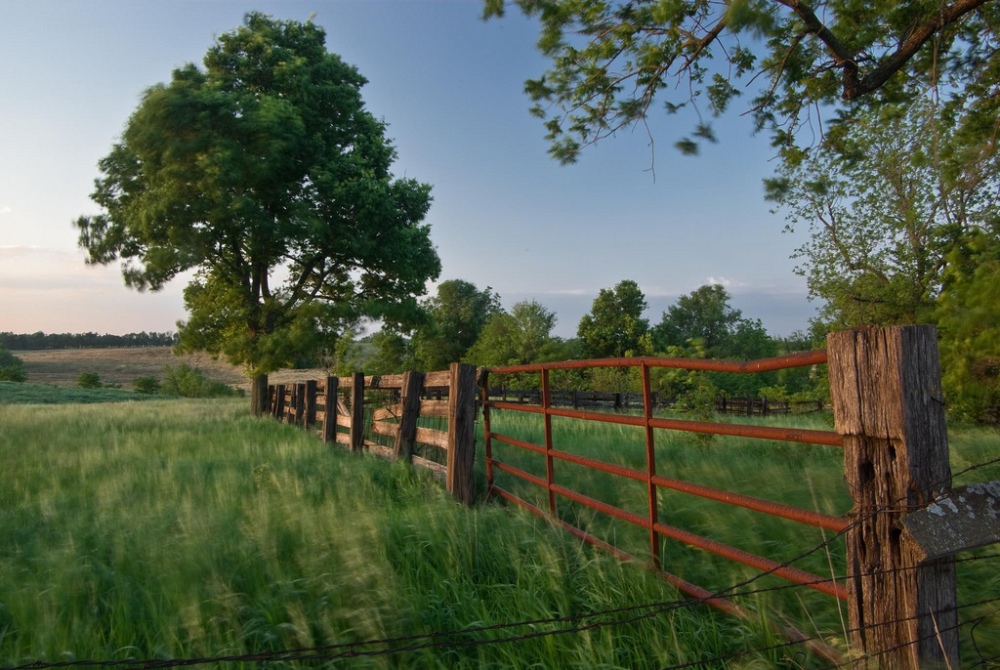
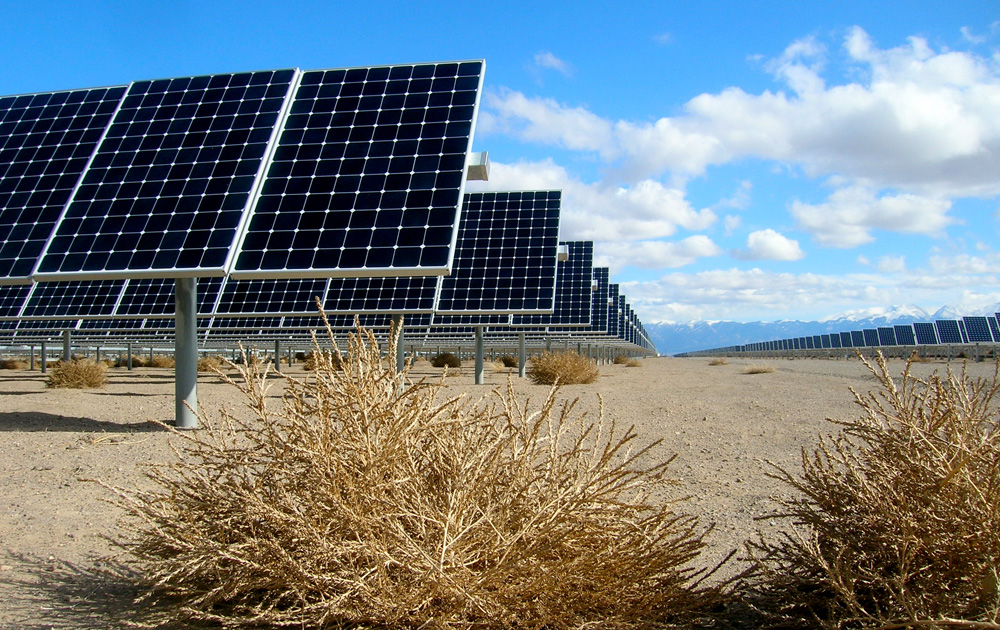
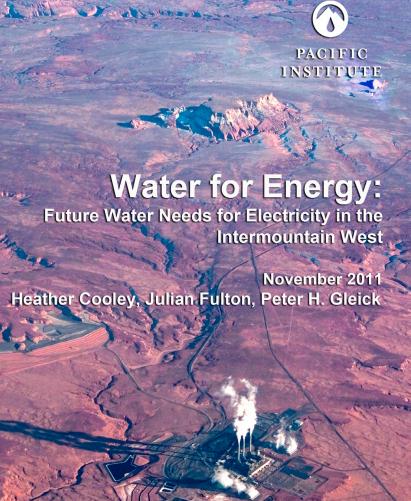



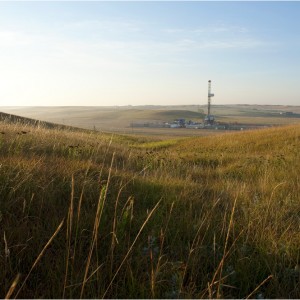
1- we have suppressed forest fires for so long, current fires become un-manageable; cost millions-billions to control, suppress and repair what’s lost; and have changed the landscape drastically – one result is the massive pine bark beetle outbreaks
2- property rights advocates, conservatives, etc will hate this comment but a lack of regional (as in multi-state) and/or federal oversight of water resource (surface and ground) allocation and planning of business, residential and agricultural development has led to the current crisis. I do not care if you want the “right” to do whatever the “local” land use code says. THE western water crisis threatens national security and this extends to competition that exists between communities, counties and states for jobs, residents and tax revenues.
3- the best thing that could happen is:
prioritize national security issues related to mfg/business, agricultural, and population centers
regionalize or ‘federalize’ all water rights (ground and surface) – remove local and state control of water, it is a common resource needed by all
remove un-needed dams (glen canyon anyone?)
Helpful blog, bookmarked the website with hopes to read more!